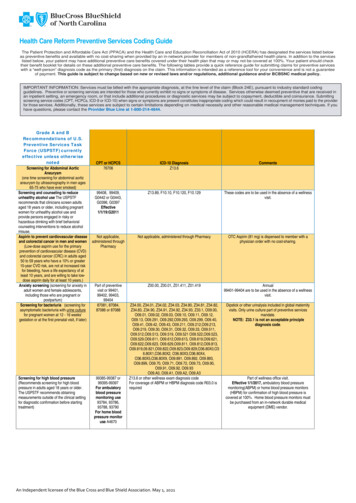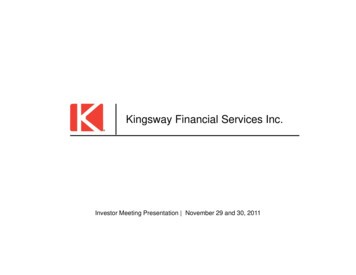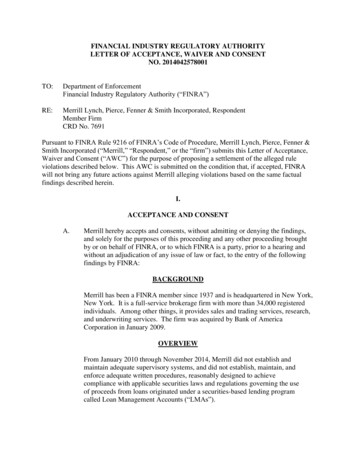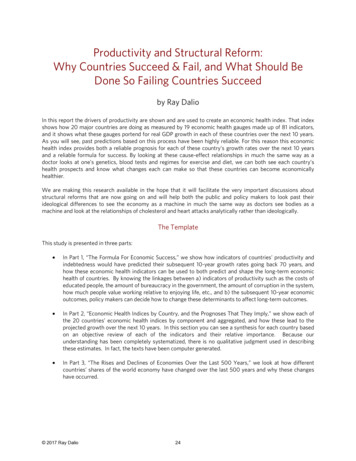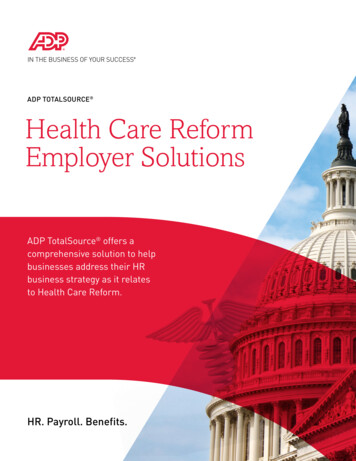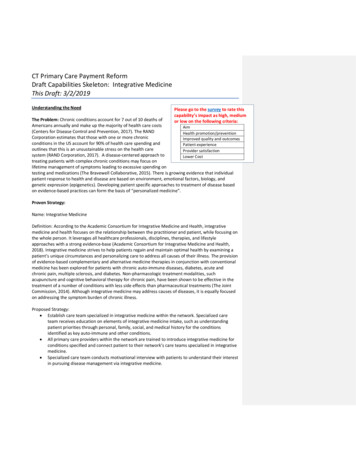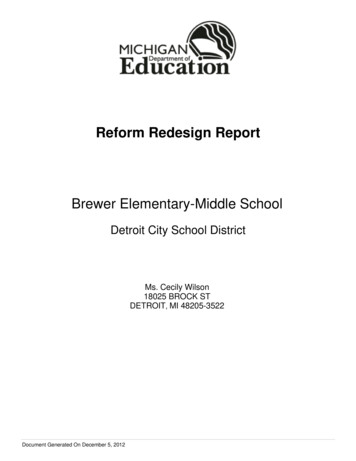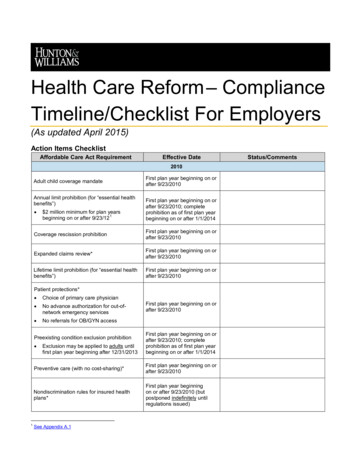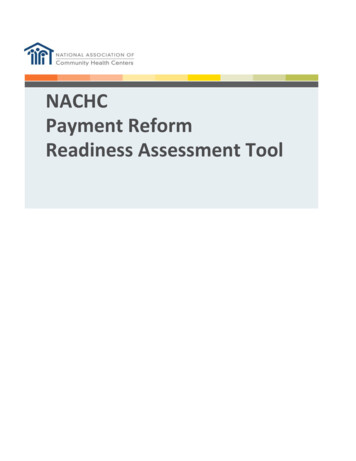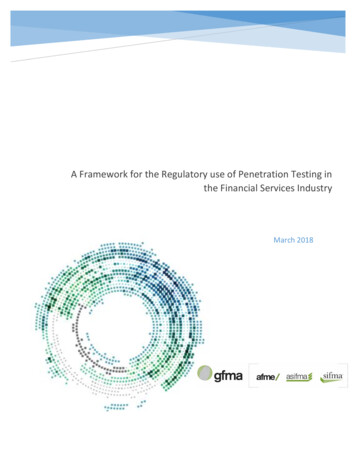![Financial Services Regulatory Reform (00C) [Read-Only]](/img/2/2018-03-29-davis-polk-financial-services-regulatory-reform-tool-march-2018.jpg)
Transcription
Financial Services Regulatory Reform in 2018A reference tool to be updated from time to timeVersion as of May 11, 2018These slides are designed to be a reference tool for the financial regulatory reform landscape. Theygather in one place the state of play on a number of topics and set forth our views on the generaloutlook. To stay up to date on all topics related to financial regulatory reform, we invite you to visit ourone-stop website and blog at www.FinRegReform.com. 2018 Davis Polk & Wardwell LLP 450 Lexington Avenue New York, NY 10017This communication, which we believe may be of interest to our clients and friends of the firm, is for general information only. It is not a full analysis of the matters presented and should notbe relied upon as legal advice. This may be considered attorney advertising in some jurisdictions. Please refer to the firm's privacy policy for further details
Table of ContentsFinancial regulatory reform will occur through a complex mix of changes in personnel, regulations, statutes,interpretations and guidance, with the courts also brought in by stakeholders on all sidesImproving Supervision and theRegulatory Engagement ModelOrderly Liquidation AuthorityAML / OFAC SanctionsSlides 28–29Slides 45–49Living WillsInternational CooperationSlides 30–31Slide 50FSOC Structure and AuthorityDerivativesSlides 11–13Slides 32–33Secure and Fair Enforcement BankingActCFPB Structure and AuthorityVolcker RuleExecutive CompensationSlides 14–16Slides 34–36Slide 52Tailored Regulation by Size andBusiness ModelExaminationsDOL Fiduciary RuleSlides 37–39Slides 53–54Capital, Liquidity and Stress TestingCommunity Reinvestment ActFintech ChartersSlides 22–26Slide 40–41Slide 55U.S. IHCs of FBOs and EPS Applicable toFBOsEnforcement FocusCybersecuritySlides 42–44Slides 55–58Slides 5–7Federal Reserve Independence,Transparency and StructureSlides 8–10Slides 17–21Slide 27Slide 51GSE ReformSlides 59–601Version as of 5/11/2018
Complex Mix of Legislative and Regulatory ChangesHOW CHANGES WILL BE MADEExecutive Order and Treasury ReportsPresident Trump issued an Executive Order on Core Principles for Regulating the UnitedStates Financial System (Core Principles)February 2017The Treasury Department has published five reports on the conformity of U.S. financial regulations to theCore Principles, all of which are designed to influence financial regulatory reform: A Financial System that Creates Economic Opportunities: Banks and Credit Unions(Treasury Banking Report)June 2017 A Financial System that Creates Economic Opportunities: Capital Markets(Treasury Capital Markets Report)October 2017 A Financial System that Creates Economic Opportunities: Asset Management andInsurance (Treasury Asset Management Report)October 2017 Financial Stability Oversight Council Designations (Treasury FSOC Report)November 2017 Orderly Liquidation Authority and Bankruptcy Reform (Treasury OLA Report)February 2018The Treasury Department will publish one additional report containing recommendations on non-bankfinancial institutions, financial technology and financial innovation2to Table ofcontentsVersion as of 5/11/2018
Complex Mix of Legislative and Regulatory ChangesLEGISLATIVE DEVELOPMENTS Several legislative proposals form the backdrop for the overall regulatory reform policy discussion and arereferred to throughout these slides The Economic Growth, Regulatory Relief and Consumer Protection Act (Bipartisan Banking Bill) was passed bythe full Senate on March 14, 2018 The Bipartisan Banking Bill had significant support from both sides of the aisle, with 16 Democrats and 1Independent joining all 50 voting Republicans in passing the final bill Discussion of the Bipartisan Banking Bill has now moved to the House. If the House passes a version of thebill that differs from the Senate version, these differences will need to be reconciled in conference and sentback to both chambers. Whether any revised version of the bill would maintain its strong bipartisan support –essential to surviving a filibuster – in the Senate is unclear, with one of the bill’s Democratic supporters,Senator Warner, threatening to “encourage all 17 [Senate] Democrats who previously voted for the bill to voteagainst it” if the House makes changes On April 5, President Trump reiterated his support for the bill, saying “it should be done fairly quickly” The Financial CHOICE Act of 2017 (CHOICE Act) was passed by the full House on June 8, 2017 Reflects House Republican positions on a wide range of topics but is no longer being proposed in the form ofone comprehensive bill Components of the CHOICE Act have been passed by the House as separate bills and may be proposed on anà la carte basis as further standalone bills or as amendments to Senate bills as they are considered by theHouse. Rep. Hensarling has tempered his early insistence on bicameral negotiations of additional measures asa condition of the House’s consideration of the Bipartisan Banking Bill, conceding that he is satisfied bymovement toward provisions of the CHOICE Act and other initiatives becoming law through separate billsrather than as a part of the Bipartisan Banking Bill itself On April 30, House Speaker Paul Ryan predicted the Bipartisan Banking Bill would become law within “a fewweeks”3to Table ofcontentsVersion as of 5/11/2018
Complex Mix of Legislative and Regulatory ChangesLEGISLATIVE DEVELOPMENTS The Systemic Risk Designation Improvement Act (SRDIA) in its original form passed the full Housein December 2016 but did not proceed further. A modified version was reintroduced in the newCongress in July 2017 by Rep. Luetkemeyer The Financial Regulatory Improvement Act of 2015 (FRIA) was introduced in June 2015 by formerSenate Banking Committee Chair Richard Shelby House Speaker Paul Ryan’s policy agenda, A Better Way (Better Way), was published in June2016. In light of Speaker Ryan’s announced retirement from the House later this year, however, it isuncertain whether and to what extent this policy agenda may progress before he leaves Congress orbe adjusted after his successor is elected The Financial Institutions Bankruptcy Act (FIBA), which is based on the Hoover Institution’s Chapter14 proposal and would add a new Subchapter V to Chapter 11 of the Bankruptcy Code, was passedby the House in April 20174to Table ofcontentsVersion as of 5/11/2018
Improving Supervision and the Regulatory EngagementModel General Outlook: Change likely in how regulators engage with the banking sector The Treasury Banking Report includes several recommendations for an improved regulatory engagementmodel Goals of mutual accountability and common understanding of responsibility between the banks andregulators Will also review interagency guidance, such as policy statements, to update and streamline guidance In his April 17 testimony before the House Financial Services Committee, Vice Chair Quarles stated that“the regulation of [the financial] system should support and promote the system’s efficiency just as itpromotes its safety,” and focused on a supervisory framework based on the three principles of efficiency,transparency and simplicityVice Chair Quarles has said that “changing the tenor of supervision” will “be the biggest part” of what he willdo as Vice Chair, “particularly in the early stages” of his tenureFor more information on improving the regulatory engagement model, please visit the Fin Reg blog – “Davis Polk Comments on Federal Reserve’s Proposed Guidance on BoardGovernance” (Feb. 16, 2018), “Federal Reserve Signals Long-Overdue Re-examination of BHC Act Control Framework” (Jan 24, 2018), “As Regulatory Reform Push Continues,Federal Reserve Vice Chair for Supervision Randal Quarles Sets Out His Guiding Principles” (Jan. 23, 2018), “Federal Reserve Proposes New Guidance on Management ofLarge Financial Institutions” (Jan. 8, 2018), and “Federal Reserve Proposes New Guidance on Corporate Governance (August 7, 2017)5to Table ofcontentsVersion as of 5/11/2018
Improving Supervision and the Regulatory EngagementModel Potential Methods of Change: The Treasury Banking Report recommends reassessing regulatory requirements on a bankingorganization’s Board of Directors Notes that duties imposed on Boards “lack appropriate tailoring and undermine the important distinctionbetween the role of management and that of Boards” The Federal Reserve proposed guidance in August 2017 that would rescind or revise some of the existingsupervisory expectations for bank holding companies and that would clarify the role of the Board in addressingMRIAs and MRAs Recommends an inter-agency review of the collective requirements imposed on Boards to tailor aggregateexpectations and strike a better balance between Board and senior management responsibilities Vice Chair Quarles has characterized the purpose of the August 2017 proposed guidance as intended to“scale back some of the excessive micromanagement” of boards The Treasury Banking Report recommends that the independent financial regulatory agencies perform andmake available a cost-benefit analysis for “economically significant” proposed regulations and strive toachieve greater consistency in their methodology and use of cost-benefit analysis The Federal Reserve has established a new office that, according to Chair Powell, will “focus veryparticularly on cost-benefit analysis” Vice Chair Quarles has asked his staff to conduct a comprehensive review of regulations related to capital,stress testing, liquidity and resolution in order to evaluate the costs and benefits of those regulationsFor more information on improving the regulatory engagement model, please visit the Fin Reg blog – “Federal Reserve Signals Long-Overdue Re-examination of BHC Act ControlFramework” (Jan 24, 2018) and “As Regulatory Reform Push Continues, Federal Reserve Vice Chair for Supervision Randal Quarles Sets Out His Guiding Principles” (Jan. 23,2018)6Version as of 5/11/2018
Improving Supervision and the Regulatory EngagementModel Potential Methods of Change: The Treasury Banking Report also recommends improvements to the process for remediating regulatory issues Recommends an inter-agency reassessment of the volume of MRA, MRIAs and consent orders Recommends that regulators and banks develop an improved approach to clearing regulatory actions toreduce multi-year delays In December 2017, Former Chair Yellen stated that the Federal Reserve was “evaluating its general approach toissuing guidance” after the Government Accountability Office (GAO) determined that the 2013 InteragencyGuidance on Leveraged Lending was a “rule” under the Congressional Review Act and so could not becomeeffective until it was submitted to Congress Before making its determination, the GAO sought comment from the OCC’s Chief Counsel and the GeneralCounsels of the Federal Reserve and the FDIC, each of whom insisted that the Interagency Guidance was notbinding—this claim is difficult to credit, given public reports that the agencies had issued MRIAs and MRAsbased on the Interagency Guidance In late February 2018, Comptroller Otting stated that, with respect to leveraged lending, “you have the right todo what you want so long as it does not impair safety and soundness. It’s not [the OCC’s] position to challengethat” Vice Chair Quarles has mentioned specifically that the Federal Reserve is revising the process for controldeterminations under the Bank Holding Company Act in order to make that process more transparent, simpler tounderstand, and easier to apply, including the codification of the determination framework and the liberalization ofunspecified “existing limitations”For more information on improving the regulatory engagement model, please visit the Fin Reg blog – “Federal Reserve Signals Long-Overdue Re-examination of BHC Act ControlFramework” (Jan 24, 2018) and “As Regulatory Reform Push Continues, Federal Reserve Vice Chair for Supervision Randal Quarles Sets Out His Guiding Principles” (Jan. 23,2018)7to Table ofcontentsVersion as of 5/11/2018
Federal Reserve Independence, Transparency and Structure General Outlook: Moves to limit the Federal Reserve’s monetary policy discretion and increase transparency seem to have faded intothe background for now Chair Powell, however, stated at his confirmation hearing that he is “strongly committed” to an independent FederalReserve that conducts monetary policy “without a view to political outcomes” Chair Powell also expressed support for the current institutional structure of the Federal Reserve with regard to theexistence and participation of Federal Reserve Banks in monetary policy Vice Chair Quarles has noted the need to “balance two objectives – democratic accountability and independencearound the monetary policy function” Potential Methods of Change: The CHOICE Act would: Limit the Federal Reserve’s independence in many areas, including monetary policy The Federal Reserve would be required to set federal funds rate, discount rate and rate on reserve requirements using TaylorRules and explain deviations from reference formulas Create a Centennial Monetary Commission charged with examining the role of the Federal Reserve as a central bankand its current dual mandate Make all Federal Open Market Committee (FOMC) meetings recorded with a transcript made public—current custom isrelease after 5 years Subject the Federal Reserve’s and other agencies’ rulemaking to explicit and stringent cost-benefit requirements, withmajor regulations requiring Congressional resolution to become effective8to Table ofcontentsVersion as of 5/11/2018
Federal Reserve Independence, Transparency and Structure Potential Methods of Change: Earlier versions of the Dodd-Frank bill would have eliminated the Federal Reserve Banks Private ownership of Federal Reserve Banks has been criticized By contrast, the CHOICE Act would increase the number of Presidents of the Federal Reserve Banks on theF
29.03.2018 · 2016. In light of Speaker Ryan’s announced retirement from the House later this year, however, it is uncertain whether and to what extent this policy agenda may progress before he leaves Congress or be adjusted after his successor is elected The Financial Institutions Bankruptcy Act (FIBA), which is based on the Hoover Institution’s Chapter
